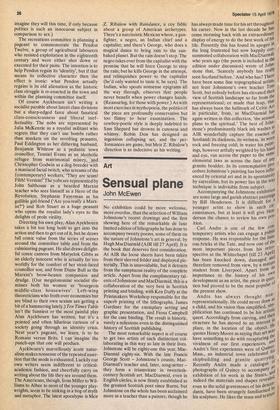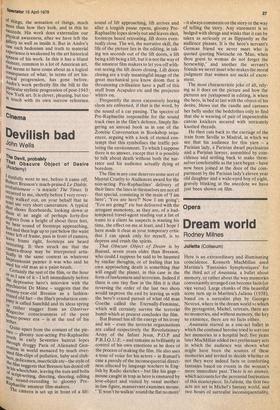Art
Sensual plane
John McEwen
No exhibition could be more welcome, more overdue, than the selection of William Johnstone's recent drawings and the first showing here of the remarkable de luxe limited edition of lithographs he has done to accompany twenty poems, some of them on the nature of Johnstone's art in general, by Hugh MacDiarmid (AIR till 27 April). It is the book that deserves first consideration. At AIR the loose sheets have been taken from their sleeved folder and displayed pictorially. This is unavoidable, but it detracts from the sumptuous reality of the complete article. Apart from the complimentary talents of Johnstone and MacDiarmid, this is a collaboration of the very best in Scottish printing and binding, with Ken Duffy at the Printmakers Workshop responsible for the superb printing of the lithographs, James Gardiner for the exemplary setting and graphic presentation, and Fiona Campbell for the case binding. The result is historic, surely a milestone even in the distinguished history of Scottish publishing.
The most remarkable aspect is of course to get two artists of such distinction collaborating in this way so late in their lives. Johnstone will be eighty-one this year, MacDiarmid eighty-six. With the late Francis George Scott — Johnstone's cousin, MacDiarmid's teacher and, later, song-setter — they form a triumvirate in twentiethcentury Scottish art. MacDiarmid, even in English circles, is now firmly established as the greatest Scottish poet since Burns, but Johnstone on the whole has been acclaimed more as a teacher than a painter, though he
has always made time for his art throughout his career. Now in the last decade he has come storming back with an extraordinarY display of energy to do the best work of his life. Presently this has found its apogee in the long frustrated but now happily CO' ' summated collaboration with MacDiarmirlr who years ago (the poem is included in the edition under discussion) wrote of John' stone that, 'Scarcely anybody has reallY seen Scotland before.' And who has? There have been some fine topographical artists, not least Johnstone's own teacher Tori... Scott, but nobody before has elevated theu view of Scottish landscape so far from the representational; or made that leap, that has always been the hallmark of Celtic Art in particular, from, as MacDiarmid hes, again written in this collection, 'the sensuw plane to the spiritual.' The best of John' stone's predominantly black ink washes at AIR wonderfully capture the essence nf Scotland: its darkness, its wetness, its worn rock and freezing cold; in water his paint,: ings, however artfully weighted by his haw" and eye, run across the paper to the sante elemental laws as across the face of allY granite boulder. In its contemplative Pro" cedure Johnstone's painting has been lain. enced by oriental art and in its spontaneitY by surrealism, but its power lies in the way technique is indivisible from subject. Accompanying the Johnstone exhibition are some large and garish abstract paintings by Bill Henderson. It is difficult for, a younger artist to show in such er" ' cumstances, but at least it will give Hen' derson the chance to review his own PO" it ion. Carl Andre is one of the few colt' temporary artists who can engage a public response. He was responsible for the ous bricks at the Tate, and now one of the most important pieces from his retrospective at the Whitechapel (till 23 API has been knocked down, damaged one therefore removed from view, by a mattt.e,‘ student from Liverpool. Apart from n' importance to the history of his nvih development as an artist, the piece tion had proved to be the most popular the present show. Andre has always thought n°111 representationally. He could never draw a child, and his vision thus simplified, Win,
plification has continued to be his artistquest. Accordingly from carving, and the!'
structure he has moved to an interest ,n; place, in the location of the object. quotes Henry Moore as saying that art alaYe have something to do with recapturing thd vividness of our first experiences, an., Andre's first experiences were of Quin,c'r. Mass., an industrial town celebrated, In shipbuilding and granite quarrYnogi Recently Andre made a catalogue an photographs of Quincy to accompany exhibition of his work in the States, and, indeed the materials and shapes reveille even to the solid gravestones of his desee,!; dants, have been strangely familiarised
his sculpture. He likes the mass and tan."'
of things, the sensation of things, much °lore than how they look, and in this he succeeds. His work does externalize our Physical awareness, after we have left the isillery as well as inside it. But in Andre's case such hedonism and truth to material esPerience is weakened by the art historical aptness of his work. In this it has a bland element, common to a lot of American art, that seems to have come about as a logical consequence of what, in terms of art histA°I.Ical progression, has gone before. toulre's work perfectly fits the bill in the Particular stylistic progression of post-1945
ew York art. It is clever, pleasing, but too' lo touch with its own narrow reference.



































 Previous page
Previous page